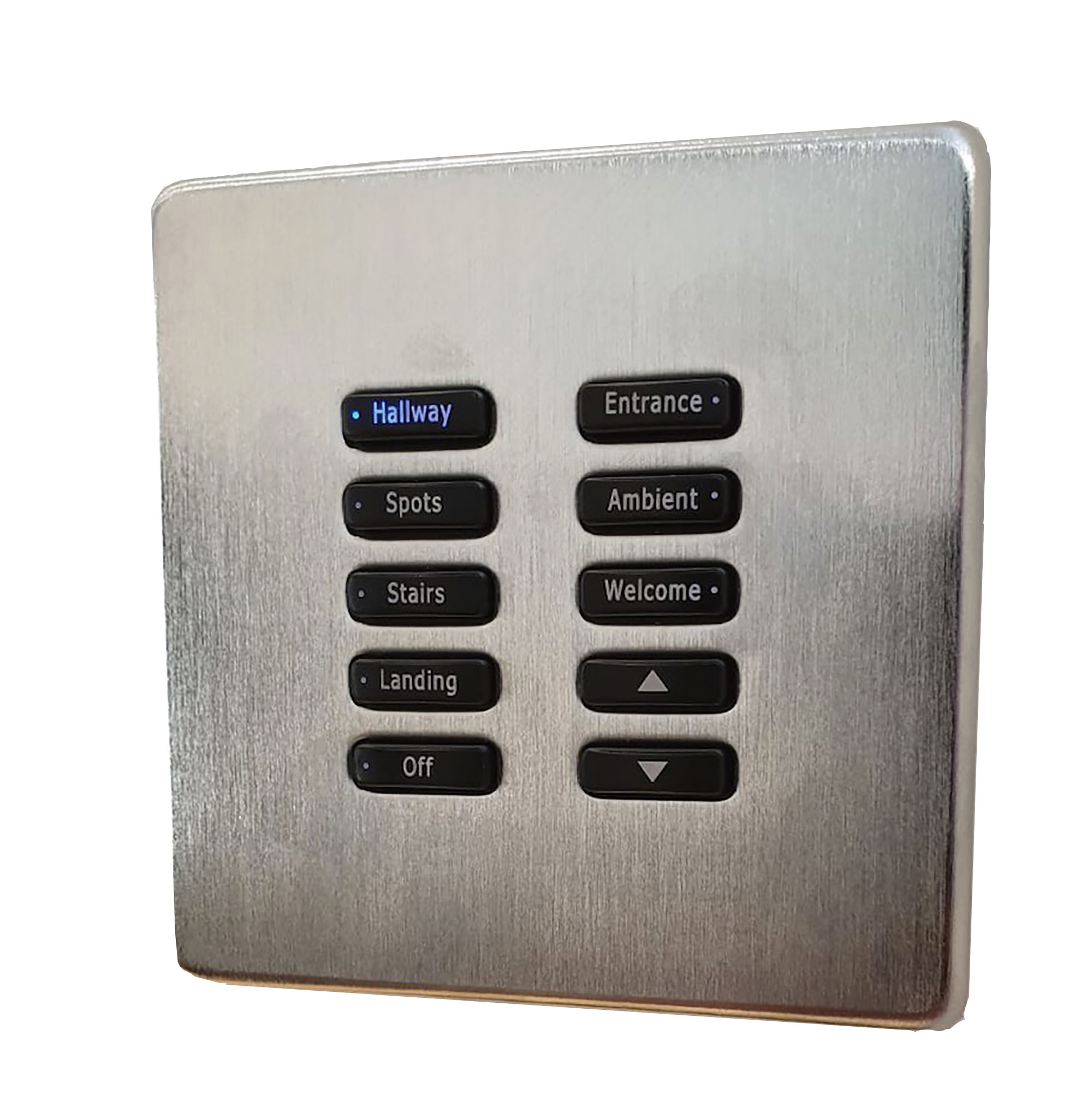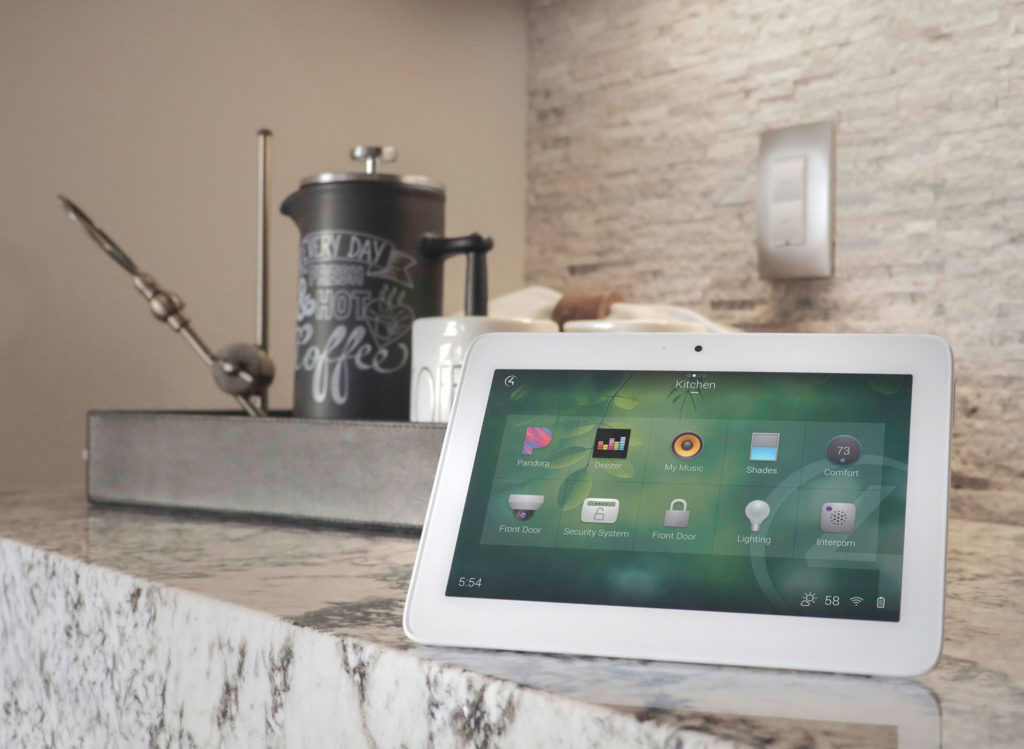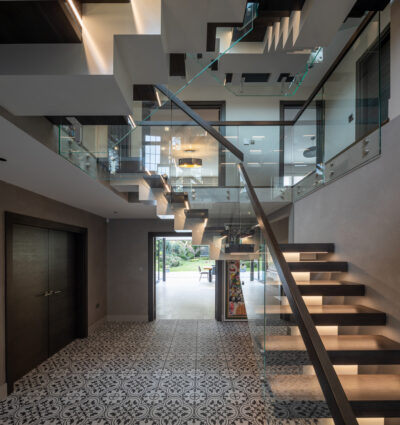Installing Smart Lighting
Technology for the home is getting ever smarter and bespoke lighting designs are becoming far more prevalent.
This is particularly true for self build projects where a tailored approach is often the motivation for building from scratch.
So how can smart lighting help here and how does it work?
Smart lighting control
Having a single way – like an app or remote control – to manage your home’s lighting is what makes it a smart system.
You can pre-set for specific lighting arrangements to come on at one time to suit different moods and activities. For instance, in an open-plan kitchen-dining-living space there should be settings for cooking, relaxing, dining etc.

The labelled buttons on this smart switch from Link It Solutions make it clear how to recall each scene
If your designer has done their job and the control system gels together with this, all you need to do is press one button. This should recall the specific light levels needed for that particular mood.
“If it’s done well, it feels like magic. But it’s a magic created by the lighting design and the control system working in tandem – it’s the quality of the design that makes the biggest visual difference,” says Melanie Shaw, design director at Brilliant Lighting.
Where should it be installed?
Smart lighting can be fitted either as a standalone feature, or as part of a wider integrated home – the key is to make sure it’s where you need it.
These systems are popular in open-plan spaces like kitchen-diners or living rooms, and also in main bedrooms and exterior zones like the driveway or garden.
| Find the perfect finishing touches for your project at Build It Live. Watch live presentations on a variety of self build and renovation topics, browse thousands of products and get your specific questions answered.
Build It Live takes place three times a year in Kent, Oxfordshire and Exeter. The next show will be on 8th and 9th June 2024, in Bicester, Oxfordshire. Claim a pair of free tickets today and start planning your visit. |
Installing smart lighting in these areas is ideal because you might perform a variety of tasks that require different lighting arrangements, such as cooking, relaxing or hosting – all of which need various levels of brightness and ambience.

John Cullen Lighting has created this stunning bathroom scene by using a mixture of uplights, floor washers and downlights, controlled by a single system
Chris Harrill, director at Azro, explains this further. “Smart lighting uses pre-defined lighting levels to create multiple scenes for different activities. One single button can call up these settings, changing the look and feel of spaces quickly and effectively,” he says.
Having this sort of predetermined approach allows homeowners to create the perfect lighting arrangement for their household. Working with a specialist is key to achieving the best solution for a bespoke setup.
Designing your system
Depending on your project, you’ll either be looking at a retrofit option, which could be wireless (more on this later), or you’ll need a fully wired solution. Whichever route you choose, “getting the professionals in as early as possible is paramount,” says Philipp Schuster, managing director at Loxone UK.
Read more: How to Create an Automated Lighting System
This could range from a specialist lighting designer, who will come up with a scheme to ensure your home has no dark voids, to a smart technology expert, who can advise on the best solution to achieve your design (smart lighting companies will often provide both services).
WHOLE HOME CONTROLIf you’re looking for a completely smart house, you will need to consider how the system will integrate with the rest of the property. You can connect your lighting with other home technology, such as heating, security and audio visual. Hubs like Control4 or Creston provide a unified way to control a wide range of different sub-systems, including lighting, but from a single app or remote control. This integration allows you to create even more specific moods and scenes. “With solely a lighting control system, you can have total control over this one variable – the lights turn off when you activate ‘Leave House’; your bathroom lights can be at 100% during the evening, but only 10% in the small hours,” explains Andy Moss, managing director of Moss Technical. “With a whole house system, like the Niko Home Hub, we can control so many other aspects of the home. If someone comes to call at the house, we might automatically lower your music so you hear the doorbell. Or, if you don’t want to wake the baby, we can flash the lights in the kitchen instead,” he says. This kind of integration should be designed early on to best suit your needs – though retrofit solutions are possible. |
Depending on the scale of your project, you may also need to employ an electrician to run your smart home cabling.
“You’ll be able to discuss your requirements with an expert and they’ll recommend what is possible – both practically and from an aesthetics point of view,” says Philipp.
It’s crucial that you engage a designer who can advise on different elements of the scheme – it’s all very well having fancy ideas and elaborate plans, but if you’re informed about what is practical beforehand, you’ll save a lot of time and money when you go to look for products or a smart technology installer for the system.


If you’re opting for a fully wired solution, you’ll need to work with an electrician to get the cabling and fixtures in to realise your plan for different lighting zones. This is more typical in new build homes, which are being created from scratch and can more easily accommodate the cabling.
If your budget doesn’t stretch to a whole-house integrated lighting system, it’s possibly still worth adding the correct cabling, in case you want to install it later on.
“Your wiring infrastructure is the backbone of your home,” says Philipp. “Having to open up walls to pull extra cables is costly and inconvenient – it’s important to speak to both a competent electrician and a smart home professional early on in the build to help design a suitable system.”
The key thing is for you to be involved in every step of the design process. “Whenever the end user isn’t involved, the smart lighting system can lead to frustration and confusion because it might not work in the way you expect,” says Luke Thomas, design director of John Cullen Lighting.
“It has to be designed around the inhabitants and how they use the space – there’s no sense in creating a bespoke solution if it doesn’t work for them.”
Retrofitting smart lighting
While most installers prefer to work with a blank slate, it is still possible to have a smart lighting setup if you’re renovating.
“There are many solutions that can be used for an already decorated home,” says Steve Itoje, managing director of Link It Solutions.
“Wireless systems are the most common. Some of these can use the existing, non-smart switches.” The typical fix for a smart lighting retrofit is using smart bulbs, such as Philips Hue.
This is a popular DIY solution that can be controlled by wireless home hubs, like Alexa and Google Assistant, as well as from your smartphone. Options like these normally require a robust wifi signal though, so if this is a challenge in your area, it may not be the best solution.
| ADDITIONAL BENEFITS
Smart lighting has a number of advantages, and can be implemented in various spaces, both in internal rooms and external areas.
|
If you’re planning a larger scale renovation project, or gutting your entire house, for example, then a wired system might be preferable.
Still, it’s advisable that you speak to an expert to make sure your DIY plans are viable and not too complex.
“While it’s generally a good idea, there are some rooms where smart lighting might not make sense, like cloakrooms or utility spaces,” says Steve. Instead, a PIR (passive infrared sensor) that turns on when you walk in may be a better fit.
How much will it cost?
As smart lighting systems are bespoke, it can be difficult to put a price on them. DIY options such as the Philips Hue bulbs can start from a few £100s.
However, installing a full house wired solution can cost anywhere from £5,000 up to £10,000s. It’s important that you know what your budget can stretch to before starting work.
Incorporating smart lighting will help prepare your home for the future, so if you’re debating between an extra few £1,000s on furnishings versus cabling infrastructure, you may decide that it’s better to forego those decorative pieces for a year or so, in order to make a smarter house.


































































































 Login/register to save Article for later
Login/register to save Article for later












